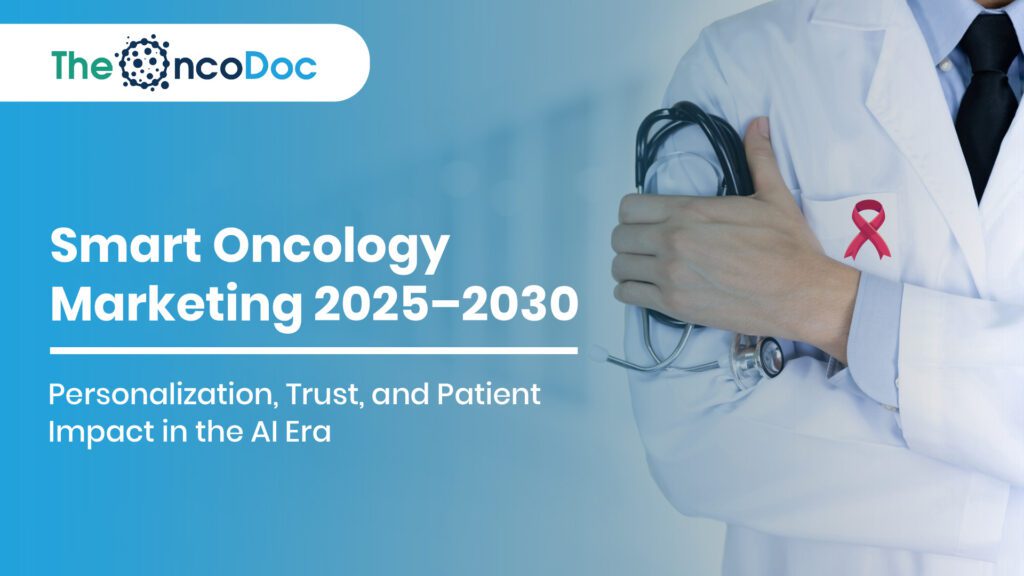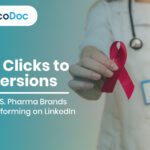Introduction: From Drug Promotion to Digital Healing Ecosystems
In the next five years, oncology marketing will not just sell treatments, it will build AI-powered ecosystems that prioritize early detection, patient empowerment, and lifelong survivorship care. Pharmaceutical companies are transitioning from “product-first” to “patient-first” strategies, recognizing that informed, emotionally supported patients are more likely to seek timely diagnosis and adhere to treatment.
The most revolutionary factor in this change is artificial intelligence (AI). From predictive patient segmentation to emotional sentiment tracking, AI allows pharma marketers to detect emerging needs, tailor interventions, and respond faster than ever before. Combined with hyperlocal campaigns, digital tools for oncologists, and collaborative healthcare networks, AI is enabling precision marketing that is as targeted as precision medicine itself.
This article explores new trends, tactics, and technologies defining oncology pharma marketing between 2025 and 2030, focusing on actionable, patient-centric, and AI-enhanced strategies.
1. AI-Enhanced Patient-Centric Campaigns
While traditional oncology marketing targeted healthcare providers, the patient journey now starts much earlier, often online, long before the first doctor visit. AI tools can analyze millions of anonymized searches, social posts, and app interactions to identify patients at risk and deliver hyper-relevant educational content.
New Tactics:
- AI-driven dynamic ads that change in real time based on the patient’s browsing behavior and local cancer trends.
- Interactive WhatsApp chatbots in vernacular languages guiding users through symptom self-assessments.
- Predictive content delivery, where AI recognizes a user’s digital “health signals” and sends preventive care nudges before symptoms worsen.
Impact: AI personalization has been shown to increase engagement in oncology awareness campaigns by up to 48% compared to generic content.
2. Hyper-Personalized AI Segmentation
Oncology is too diverse for a one-size-fits-all approach. AI can segment audiences not just by cancer type but by behavior, cultural context, and access to healthcare.
Examples:
- For urban women aged 40–55 searching “lump in breast” or “breast pain,” AI can push targeted mammogram booking campaigns with hospital tie-ups.
- For rural populations with high oral cancer prevalence, AI might prioritize tobacco cessation messages delivered via voice-based channels.
This micro-targeting ensures every campaign feels personally relevant, increasing trust and action rates.
3. Empowering General Practitioners (GPs) with AI Tools
GPs are often the first line of defense in cancer detection, yet many lack specialized oncology training. AI can be used by pharmaceutical corporations to improve GP engagement:
AI-powered GP dashboards suggesting screening protocols based on patient symptoms.
- Real-time decision-support tools integrated into electronic medical records (EMRs).
- Predictive alerts to flag local spikes in specific cancer risk factors, prompting GPs to initiate targeted checks.
Such tools not only improve referral rates but also position pharma as a knowledge partner rather than just a drug supplier.
4. Omnichannel AI-Optimized Marketing
Modern oncology campaigns thrive on channel orchestration, ensuring a patient sees consistent, reinforcing messages across multiple touchpoints. AI optimizes channel mix by:
- Predicting the best time of day for each patient segment to receive content.
- Adjusting messaging tone and format depending on platform (e.g., empathetic survivor stories on Instagram, scientific infographics on LinkedIn).
- Midway through a campaign, conducting ongoing A/B testing to improve content.
By integrating AI-driven media planning, pharma marketers reduce spend waste while boosting impact.
5. Behavioral Science Meets AI
Behavioral nudges already work in healthcare marketing, but AI takes them further by personalizing when and how they’re delivered.
AI-Driven Nudge Examples:
- Personalized screening reminders sent during cultural festivals when family health discussions are more common.
- Gamified cancer risk quizzes where AI tailors follow-up content based on quiz answers.
- AI-detected emotional fatigue triggers that prompt gentle motivational messages instead of aggressive calls to action.
The patient will feel guided rather than under pressure thanks to this careful nudging.
6. Emotionally Intelligent Storytelling
AI-powered sentiment analysis can determine which survivor stories resonate most with different demographics. For instance, a working mother’s recovery story might engage urban professional women, while a farmer’s early detection journey could resonate more in rural districts.
Pharma companies can use AI to:
- Arrange the material themes based on their degree of participation and emotional resonance.
- Localize video scripts to align with community values.
- Identify influencer-survivors within niche groups for authentic storytelling.
7. AI in Predictive Campaign Planning
AI predictive analytics can detect subtle, pre-clinical indicators of cancer prevalence in certain regions, allowing pharma brands to launch preventive micro-campaigns ahead of time.
Scenario:
If AI detects a spike in searches for “blood in stool” or “persistent cough” in a certain city, pharmaceutical companies can:
· Alert local GPs.
· Launch geo-targeted awareness ads.
· Work along with healthcare facilities to set up makeshift screening camps.
This transforms marketing into proactive health intervention.
8. Vernacular + Voice AI Outreach
For oncology marketing in rural and semi-urban areas, voice AI and vernacular modification are crucial.
- Provide symptom explanations in over 20 Indian languages.
- Detect distress or urgency in a caller’s tone and prioritize response.
- Enable voice-based WhatsApp bots for low-literacy populations.
This removes literacy barriers, making cancer awareness accessible to all.
9. Digital Tools for Oncologists
Beyond patients, pharma companies can win trust by supporting oncologists with AI-enabled professional resources:
- Oncology research digests are provided regularly by AI literature summarizers.
- Virtual tumor boards where specialists discuss rare cases with AI-curated recommendations.
- Patient adherence trackers alerting oncologists when follow-ups are missed.
These innovations strengthen clinical relationships and create brand loyalty among specialists.
10. Real Impact Metrics with AI Tracking
Clicks and likes mean little in oncology. AI enables health-first KPIs such as:
- Number of AI-assisted screenings booked.
- Change in GP referral rates post-campaign.
- Symptom-to-diagnosis time reduction.
AI dashboards can also map emotional impact, tracking whether campaigns build hope, reduce fear, or increase trust.
11. Collaborations with Local Micro-Influencers
AI can scan social networks to find trusted community figures, whether they are doctors, survivors, or health workers, with high influence but small, loyal audiences.
Micro-influencers:
- Are often more relatable than national celebrities.
- Can engage in two-way conversations with their communities.
- Help in debunking myths and encouraging screenings.
12. Gamification Meets AI
Gamification effectively engages patients, but AI takes it to the next level by creating adaptive, personalized experiences. Static quizzes and generic rewards are replaced with intelligent systems that respond to each user’s behavior, making participation more meaningful and motivating.
• Adaptive Quizzes: AI adjusts quiz difficulty and content based on user responses. Beginners receive foundational knowledge, while informed participants encounter advanced insights, ensuring learning is relevant and engaging.
• Real-Time AI Leaderboards: Participation data can be tracked across regions, with AI-driven leaderboards showing current activity levels. This encourages healthy competition among communities, clinics, or patient groups, driving broader engagement in screenings and preventive care.
• Personalized Rewards: AI identifies what motivates each participant, offering tailored incentives such as local screening vouchers, digital badges, or educational resources. Aligning rewards with personal and regional preferences enhances participation and encourages sustained health behaviors, creating a dynamic, patient-centered engagement model.
13. Wearables and AI-Driven Risk Alerts
With wearables gaining popularity, AI can monitor long-term trends in heart rate, sleep, and physical activity to detect early warning signals for cancer risk.
Pharma brands can integrate with wearables to:
- Push contextual educational content when anomalies appear.
- Encourage health checkups through incentive programs.
- Collect anonymized lifestyle data for targeted prevention campaigns.
14. Public Health Partnerships with AI Insights
Government and NGO partnerships become more powerful with AI:
- AI can identify underserved districts needing urgent screening infrastructure.
- Predict seasonal spikes in certain cancers for better resource planning.
- Track impact of national cancer policies in near real-time.
15. Virtual Support Communities Powered by AI
Online cancer communities are kept safe, civil, and educational using AI moderation:
- Auto-removing misinformation.
- Highlighting trending patient concerns to pharma teams.
- Matching new patients with mentors who share similar diagnosis journeys.
16. Emotional Sentiment Dashboards
AI can turn millions of social media comments into emotion heatmaps, helping pharma:
- Detect public anxiety after a celebrity’s cancer diagnosis.
- Increase empathy-driven storytelling during sensitive periods.
- Adjust tone and imagery in campaigns for maximum reassurance.
17. AR/VR + AI for Doctor Training
Next-gen AR/VR tools now integrate AI to:
- Personalize oncologist learning modules based on case history.
- Provide simulated patient scenarios with AI-generated variations.
- Offer real-time performance feedback.
This keeps oncologists ahead of treatment innovations, indirectly boosting brand trust.
18. Smart Chatbots for 24/7 Oncology Support
AI chatbots are evolving into triage assistants:
- Identifying urgency level from symptom inputs.
- Connecting patients to nearest diagnostic centers.
- Scheduling teleconsultations within the same conversation.
19. AI-Powered Social Listening for Myth Busting
Cancer myths spread fast online. AI listens in real time for false claims like “herbal cure for cancer” and triggers:
- Instant fact-check videos from local oncologists.
- Educational push notifications to at-risk audiences.
20. Post-Treatment AI Care Programs
Survivorship care is becoming a marketing frontier:
- AI nutrition coaches tailoring meal plans to cancer type and treatment recovery phase.
- Virtual physiotherapy sessions triggered by wearable activity data.
- Predictive relapse risk alerts sent to both patient and oncologist.
21. Future Outlook: AI as the Bridge Between Data and Empathy
The next era of oncology marketing will be defined by brands that can balance machine precision with human compassion. AI will identify the need, personalize the message, and time the delivery, but empathy will keep the patient listening.
By 2030, we may see:
- Digital twins for personalized therapy planning.
- AI-voice companions for patients navigating diagnosis shock.
- Predictive national cancer maps enabling preventive policy.
22. AI-Powered Clinical Trial Recruitment in Oncology
Patient recruitment for clinical trials is one of the most neglected aspects of cancer marketing. A lot of patients don’t know about trials that could provide them with access to innovative therapies. By examining the following, AI can match qualified patients with pertinent clinical trials:
- EMR data and genetic profiles.
- Disease stage, comorbidities, and treatment history.
- Geographic proximity to trial sites.
Pharma brands can create educational micro-campaigns targeted to potential participants, explaining trial safety, benefits, and logistics in simple terms. This not only accelerates research but also positions the brand as an innovator working for patient benefit. In rural settings, AI-driven SMS campaigns can bridge awareness gaps, especially when combined with local language helplines to answer queries.
23. AI-Integrated Preventive Oncology Insurance Programs
Preventive care is often overlooked until symptoms emerge. Pharma companies can partner with insurers to design AI-powered preventive oncology insurance. These programs offer discounted premiums to people who:
- Complete annual screenings.
- Participate in wellness programs.
- Use wearables to maintain healthy lifestyle indicators.
AI risk scoring can dynamically adjust premiums and recommend targeted preventive actions. From a marketing perspective, these insurance tie-ups open new patient touchpoints, offering pharma an indirect yet long-term engagement channel. Educational campaigns tied to these programs can include survivor endorsements, personalized health challenges, and AI-curated diet/exercise plans.
24. Precision Geo-Fencing for Oncology Awareness
Geo-fencing uses location-based marketing, but when combined with AI, it becomes a precision outreach tool. In oncology, this means setting digital perimeters around hospitals, diagnostic labs, and even high-risk industrial areas.
When a person enters this zone, AI can trigger:
- Awareness push notifications.
- Discounts for nearby screening packages.
- Local survivor event invitations.
Example: In industrial towns with higher lung cancer incidence, visitors to certain zones could receive prompts to book low-cost lung function tests. The AI system ensures that messages are contextual, culturally sensitive, and timely, preventing spam-like intrusion.
25. AI-Based Adherence Monitoring and Motivation Systems
Cancer treatment adherence is critical, but side effects, cost, and emotional fatigue often lead to dropouts. AI can integrate with smart pill dispensers, mobile health diaries, and wearable devices to:
- Track medication intake patterns.
- Detect missed doses and send reminders.
- Offer motivational nudges from survivor mentors via video messages.
Campaigns that directly address these reasons through AI-personalized solutions, like transport assistance apps or free counseling sessions, can significantly improve adherence.
26. Ethical AI and Transparent Data Practices in Oncology Marketing
As AI becomes more central to oncology marketing, ethical use of patient data will define trust. Brands must prioritize:
- Transparent consent mechanisms in local languages.
- Data minimization, collecting only what is necessary.
- Independent audits of AI algorithms for bias detection.
From a marketing standpoint, communicating these safeguards publicly enhances brand credibility. Patients and caregivers are more likely to engage with campaigns when they know how their data is protected and why it is collected. This is especially important in cancer care, where privacy concerns are heightened due to stigma and sensitivity.
Conclusion
These additional strategies underscore that the future of oncology pharma marketing lies in AI not just as a technology, but as a trust-building tool. From trial recruitment to ethical data use, every innovation must combine precision, empathy, and transparency to truly make an impact.
The Oncodoc team is a group of passionate healthcare and marketing professionals dedicated to delivering accurate, engaging, and impactful content. With expertise across medical research, digital strategy, and clinical communication, the team focuses on empowering healthcare professionals and patients alike. Through evidence-based insights and innovative storytelling, Hidoc aims to bridge the gap between medicine and digital engagement, promoting wellness and informed decision-making.



